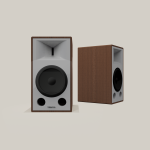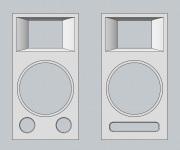A couple of questions to all the seasoned techs out there…
Horns: I’m about to build the Calpamos by Tony Gee, they feature a Thai copy of the JBL 2830A horn, I have modelled the horn and want to integrate it into the baffle constructed of mdf. I have essentially ‘sliced’ the horn into 8 layers which I will glue up and ultimately will look like a seamless part of the baffle, my question is will there be any sonic losses by constructing the horn this way, or another way of putting it is, is the resonance of the metal horn part of the ‘signature sound’ and will that be lost in a chunky mdf version of the horn!
Second question is about ports. Simply, if a baffle design has 2 round ports and I calculate the exact volume and replicate it in a different shape e.g, a single rounded rectangle, will this effect the intended bass frequency?
Thanks in advance for any insights.
Horns: I’m about to build the Calpamos by Tony Gee, they feature a Thai copy of the JBL 2830A horn, I have modelled the horn and want to integrate it into the baffle constructed of mdf. I have essentially ‘sliced’ the horn into 8 layers which I will glue up and ultimately will look like a seamless part of the baffle, my question is will there be any sonic losses by constructing the horn this way, or another way of putting it is, is the resonance of the metal horn part of the ‘signature sound’ and will that be lost in a chunky mdf version of the horn!
Second question is about ports. Simply, if a baffle design has 2 round ports and I calculate the exact volume and replicate it in a different shape e.g, a single rounded rectangle, will this effect the intended bass frequency?
Thanks in advance for any insights.
I wouldn't take it as such. The way you plan to do it is good.is the resonance of the metal horn part of the ‘signature sound’ and will that be lost in a chunky mdf version of the horn!
The (total, added) effective port surface and effective length (length of one port) need to stay the same, otherwise the tuning will change.Simply, if a baffle design has 2 round ports and I calculate the exact volume and replicate it in a different shape e.g, a single rounded rectangle, will this effect the intended bass frequency?
One single port would have the advantage of less friction and less tendency of turbulent airflow.
metl horn resonance is something that you typically want to tune out and avoid, unless you want a bad, old-timey horn sound.Is the resonance of the metal horn part of the ‘signature sound’ and will that be lost in a chunky mdf version of the horn!
Steve,Horns: I’m about to build the Calpamos by Tony Gee, they feature a Thai copy of the JBL 2830A horn, I have modelled the horn and want to integrate it into the baffle constructed of mdf. I have essentially ‘sliced’ the horn into 8 layers which I will glue up and ultimately will look like a seamless part of the baffle, my question is will there be any sonic losses by constructing the horn this way, or another way of putting it is, is the resonance of the metal horn part of the ‘signature sound’ and will that be lost in a chunky mdf version of the horn!
The P-Audio PH-2380 is constructed of high impact ABS with fiber glass filling.
The JBL 2380A is also made of (relatively) non-resonant plastic.
When screwed to a baffle, the material resonance is further damped.
Making an accurate copy of the 2380's diffraction horn throat from MDF and properly sealing it will be quite challenging.
Any differences in your copy will affect the high frequency response.
The intended Fb (box tuning frequency) of the Calpamos is 35Hz.Simply, if a baffle design has 2 round ports and I calculate the exact volume and replicate it in a different shape e.g, a single rounded rectangle, will this effect the intended bass frequency?
Even with the same cross sectional area, different shapes will require different depths to achieve the same Fb, and will also affect the port resonance frequency and reflected output through them, affecting upper bass frequency response.
Art
I think i've done a good job of modelling the wave guide but I plan on refining it after getting some more images.Making an accurate copy of the 2380's diffraction horn throat from MDF and properly sealing it will be quite challenging.
Any differences in your copy will affect the high frequency response.
This is the construction method i'm going for and after sanding and painting with 2K I think I will have a very well constructed wave guide integrated into the baffle.
Attachments
I can work out the volume of the ports pretty accurately - my question is: if I replicate the volume and depth exactly but change the 2 x round holes into 1 rectangular hole - will the frequency still be 35Hz?The intended Fb (box tuning frequency) of the Calpamos is 35Hz.
Even with the same cross sectional area, different shapes will require different depths to achieve the same Fb, and will also affect the port resonance frequency and reflected output through them, affecting upper bass frequency response.
Attachments
Will your horn be in control at the crossover frequency?modelling the wave guide
Hi, in addtion of what was said, even the position of the port will influence the tuning frequency.Second question is about ports. Simply, if a baffle design has 2 round ports and I calculate the exact volume and replicate it in a different shape e.g, a single rounded rectangle, will this effect the intended bass frequency?
I've had a problem with end correction factor and I got help from members here who posted the following picture and site.
WinISD considers k=0.732. You have to adjust it manually if you position your port close to one or more enclosure walls.
http://www.calculatoredge.com/new/ventlength.htm
embarrassingly, I don't know what this means!Will your horn be in control at the crossover frequency?
I don't know how much of an issue this may be, but the vertical dimension is the smallest and the most narrow angle. These mean it will lose directivity control first if you look at frequency dependent behaviour going down the scale. If you use it below this range, the baffle will come into play in containing the sound. Your proposed baffle is extended below but not above the horn. This could potentially cause the sound to lobe upwards or other asymmetrical vertical effects.
If the MDF horn is a reasonable copy I would think the vertical may not be an issue. There are plenty of examples of this horn used exactly as depicted. Attached in the cut sheet for a 2380A. With full loading to 500Hz and the narrow 40 degree vertical I think it will be OK. JMMV
Rob 🙂
Rob 🙂
Attachments
At the Calpomos acoustic crossover of ~650Hz, the 2380's vertical dispersion has transitioned from a nominal 40 to ~100 degrees.With full loading to 500Hz and the narrow 40 degree vertical I think it will be OK.
That said, the Calpomos crossover was designed around the dispersion of the horn and cabinet baffle dimensions and depth. As long as Steve retains the same woofer/horn center to center distance, should be as good as can be expected.
The Fb should still be pretty close to 35Hz, but the high aspect ratio port's pipe resonance(s) may increase in amplitude and be a different frequency than the circular ports:I can work out the volume of the ports pretty accurately - my question is: if I replicate the volume and depth exactly but change the 2 x round holes into 1 rectangular hole - will the frequency still be 35Hz?
You can easily adjust Fb up by shortening, or down by lengthening the port a bit, but you can't easily change the pipe resonance of a wide, narrow port.
Art
I don't know how much of an issue this may be, but the vertical dimension is the smallest and the most narrow angle. These mean it will lose directivity control first if you look at frequency dependent behaviour going down the scale. If you use it below this range, the baffle will come into play in containing the sound. Your proposed baffle is extended below but not above the horn. This could potentially cause the sound to lobe upwards or other asymmetrical vertical effects.
one thing to note is that when your horn/driver loses directivity control, you frequently also lose phase coherence, which will affect soundstage and imaging.If the MDF horn is a reasonable copy I would think the vertical may not be an issue. There are plenty of examples of this horn used exactly as depicted. Attached in the cut sheet for a 2380A. With full loading to 500Hz and the narrow 40 degree vertical I think it will be OK. JMMV
Rob 🙂
- Home
- Loudspeakers
- Multi-Way
- Ports and horns!

